University of Salerno [ 4 months ]
University of Twente [ 20 months ]
Turn on Javascript!
Turn on Javascript!
Turn on Javascript!
Turn on Javascript!
Turn on Javascript!
Turn on Javascript!
I am Saeed Mahdavy from Iran. I studied chemical engineering at Amirkabir University of Technology (Tehran Polytechnic). I have a background in process simulation. I simulated a fluidized bed for my final bachelor project by using OpenFOAM. My master thesis was a joint project between Amirkabir University of Technology (Tehran Polytechnic) and Technical University of Vienna (TU WIEN). I measured residence time distribution of non-spherical particles in a continuous rotary cylinder and used an in-house DEM code for the simulation of experiments. Then, I studied the pyrolysis process in a continuous rotary kiln and solved a model for it. Throughout my study and research, I had been a researcher in the Center of Engineering and Multiscale Modeling of Fluid Flow (CEMF) at Amirkabir University of Technology, as well as the thermal process engineering-computational fluid dynamics at Technical University of Vienna.
Now, I am an EngD (PDEng) student at the University of Twente in collaboration with the University of Salerno and the mercuryDPM. My purpose of this project is to reach a profound understanding of powder flow in a rheometer via experiments and DEM simulation. Indeed, a major part of my current research will be calibration of DEM parameters for real industrial applications.
[From 2021 - 2023 Assem Zharbossyn was ESR for this project and did signifcant experimental work. She was killed in a road traffic accident in January 2023]


This predominantly experimental project aims to determine a protocol to calibrate parameters for DEM models using both primary and (coarser) meso-particles, with a focus on mono- and bi-component powders (e.g., powders with flow enhancers).


